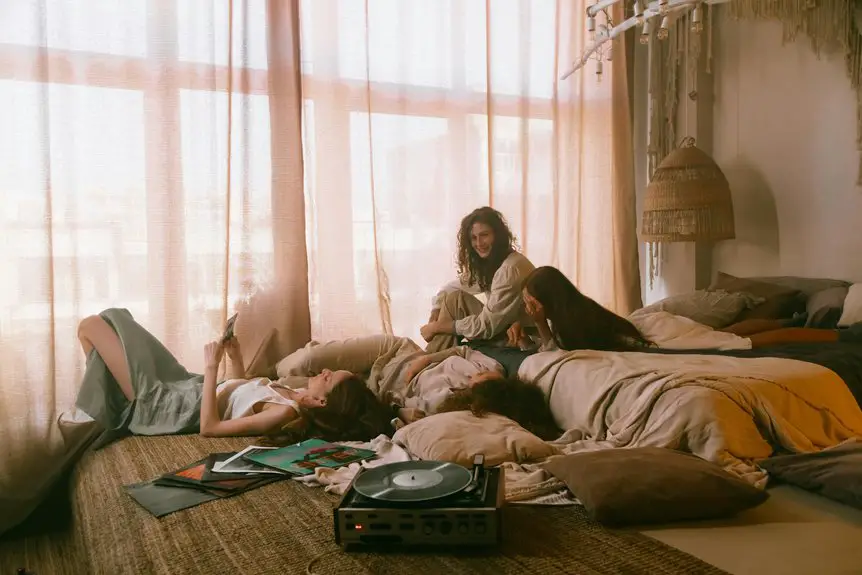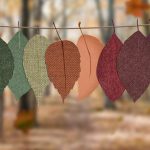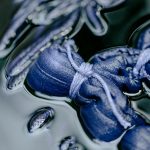When tie-dyeing large items like blankets and curtains, choose natural fabrics like cotton for vibrant colors. Pre-wash your fabric to remove residues and secure folds tightly with rubber bands. Use large tubs for soaking, squeeze bottles for dye application, and protect your workspace with tarps. Apply dye evenly in sections and keep the fabric moist during setting. Proper care includes washing gently in cold water to maintain color vibrancy. Keep going to explore techniques and tips that make your project stand out.
Table of Contents
Key Takeaways
- Use natural fabrics like cotton or rayon for vibrant, long-lasting tie-dye results on large items like blankets and curtains.
- Pre-wash large items with gentle detergent and no fabric softener to remove residues before dyeing.
- Secure fabric tightly with rubber bands or string to create clear patterns and prevent dye bleeding.
- Apply dye evenly using squeeze or spray bottles and work in sections for thorough coverage on large surfaces.
- Hang dyed items on sturdy clotheslines or drying racks and keep them moist by wrapping in plastic for proper color setting.
Choosing the Right Fabric for Tie-Dyeing
Although tie-dyeing works on many materials, you’ll get the best results by choosing natural fabrics like cotton, rayon, or silk.
These fibers absorb dye more effectively, giving you vibrant colors that last longer. Synthetic fabrics like polyester repel dye, resulting in dull or patchy patterns, so it’s best to avoid them.
Natural fibers soak up dye brilliantly, while synthetics like polyester resist it, causing dull, uneven patterns.
When selecting your item, check the fabric content label to verify it’s mostly natural fibers.
Keep in mind that heavier fabrics, like thick cotton blankets, may take longer to soak up dye evenly, so patience is key.
Also, lighter-colored or white fabrics provide a blank canvas, allowing your colors to pop.
Preparing Large Items for Dye Application
Before you start dyeing, make sure to pre-wash your large item to remove any sizing or residues that might block the dye.
Next, secure the fabric tightly using rubber bands or string to create clear patterns and prevent colors from bleeding.
Taking these steps will help your design come out vibrant and sharp.
Pre-washing Techniques
When you start tie-dyeing large items, pre-washing is essential to remove any sizing, dirt, or oils that could prevent the dye from adhering properly.
You want your colors to be bright and even, so giving your fabric a thorough wash is key. Here’s how to prep your large items effectively:
- Use a gentle detergent without fabric softener to avoid residue.
- Wash in warm water to open fabric fibers for better dye absorption.
- Avoid using bleach or harsh chemicals that can weaken the fabric.
- Rinse thoroughly to guarantee no soap remains.
- Dry your item completely or keep it damp depending on your dye instructions.
Securing Fabric Properly
Securing your large fabric properly is critical to achieving crisp, vibrant tie-dye patterns. Start by laying your blanket or curtain flat on a clean surface.
Use rubber bands or strong string to tightly bind sections of the fabric where you want the dye to resist. Don’t skip this step, because loose fabric can cause colors to bleed and blur your design.
For extra control, clip the fabric edges to a sturdy table or use weights to keep it taut. Make certain the ties are snug but not so tight they damage the fibers.
Proper securing also helps your fabric stay manageable during dye application, preventing unwanted shifts. Taking time here guarantees your large item comes out looking sharp and colorful.
Essential Tools and Materials for Large-Scale Tie-Dye
Creating large-scale tie-dye projects demands specific tools and materials that can handle bigger fabrics and more dye.
Large-scale tie-dye projects require specialized tools and materials to manage bigger fabrics and ample dye efficiently.
You’ll need to prepare your workspace and gather supplies that make the process manageable and effective. Here’s what you should have on hand:
- Large plastic bins or tubs for soaking and dyeing
- Heavy-duty rubber gloves to protect your hands
- Multiple squeeze bottles or spray bottles for even dye application
- Plastic table covers or tarps to protect surfaces
- Clothesline or drying racks strong enough to hold heavy, wet fabric
These essentials help you maintain control over the dyeing process, minimize mess, and guarantee your large items get vibrant, even color.
With the right setup, you’ll enjoy a smooth, creative experience from start to finish.
Popular Tie-Dye Techniques for Blankets and Curtains
When tie-dyeing blankets and curtains, you’ll want to try techniques that highlight their large surface area.
Spiral patterns create dynamic swirls, scrunch dyeing offers a textured, random look, and ombre effects give a smooth color gradient.
Each method lets you customize your piece with unique style and flair.
Spiral Patterns
Spiral patterns add a dynamic and eye-catching twist to large tie-dye projects like blankets and curtains.
To create this iconic design, start by laying your fabric flat and pinching the center point. Twist it tightly until the entire piece forms a spiral shape. Secure with rubber bands to hold the sections in place.
When applying dye, use vibrant colors for each wedge to enhance the spiral effect.
Here’s how to nail the spiral pattern:
- Choose a precise center for a balanced look
- Twist tightly to keep the spiral defined
- Use multiple rubber bands to create wedges
- Apply dye carefully in each wedge section
- Let the dye set fully before rinsing
Follow these steps, and your large item will boast a stunning spiral design.
Scrunch Dyeing
Although scrunch dyeing may seem simple, it produces wonderfully textured and vibrant results on large items like blankets and curtains.
To start, bunch your fabric randomly into a loose pile, scrunching it without any particular pattern. Secure it gently with rubber bands or string to keep the folds intact.
Next, apply your dye directly onto the scrunched fabric using squeeze bottles or spray bottles, focusing on different areas with various colors. The uneven surface creates unpredictable, marbled patterns that give your piece a unique, organic look.
After dyeing, wrap the fabric in plastic to keep it moist while the dye sets. Finally, rinse and dry your item to reveal the rich, mottled design only scrunch dyeing can achieve.
Ombre Effects
If you want a smooth shift of colors that feels both modern and elegant, ombre effects are an excellent choice for your blankets and curtains. This technique gradually blends one color into another, creating a beautiful gradient that adds depth and style.
You’ll love how it transforms large items with subtle sophistication.
To achieve a stunning ombre effect:
- Dip your fabric slowly into the dye, starting with a light touch
- Gradually immerse deeper for stronger color intensity
- Use colors that blend well for a seamless progression
- Let sections dry slightly before moving to the next shade
- Rinse gently to maintain the gradient without harsh lines
Give ombre dyeing a try to elevate your home décor with artistic flair.
Step-by-Step Guide to Applying Dye on Big Fabrics
Applying dye to large fabrics can feel overwhelming at first, but breaking the process into clear steps makes it manageable.
Start by preparing your workspace with plastic sheets to protect surfaces. Next, thoroughly wet your fabric to help the dye spread evenly. Lay it flat or fold it according to your chosen pattern.
Mix your dyes in squeeze bottles for easy application. Begin applying dye from the center outward or follow your design, applying colors carefully to avoid unwanted blending.
After dyeing, wrap the fabric in plastic to keep it moist and let it set for 6–8 hours. Finally, rinse the fabric under cold water until the water runs clear, then wash and dry it according to the dye instructions.
This method keeps your large project organized and vibrant.
Tips for Even Color Distribution on Large Surfaces
When working with large surfaces, you’ll want to confirm the dye spreads evenly to avoid patchy or blotchy results. To achieve consistent color distribution, focus on controlling the fabric layout and dye application technique.
Ensure dye spreads evenly on large surfaces by mastering fabric layout and application techniques for consistent color results.
Here are key tips to help you:
- Pre-wet the fabric evenly; damp fibers absorb dye better.
- Use squeeze bottles or spray bottles for controlled, uniform dye application.
- Work in sections, applying dye slowly to confirm thorough coverage.
- Fold or scrunch the fabric consistently to create even dye patterns.
- Rotate and flip the fabric during dyeing to reach all areas.
Caring for Your Tie-Dyed Blankets and Curtains
Although tie-dyed blankets and curtains brighten up any space, they require proper care to maintain their vibrant colors and soft texture.
To keep your items looking fresh, always wash them separately in cold water using a gentle cycle. Avoid harsh detergents; instead, choose mild, color-safe options. Skip bleach and fabric softeners, as they can fade colors and damage fibers.
When drying, air-dry your tie-dyed pieces or use a low heat setting in the dryer to prevent shrinking and color loss. If possible, hang curtains to dry naturally.
Also, avoid prolonged direct sunlight, which can dull the dyes. By following these simple steps, you’ll preserve the beauty of your tie-dyed blankets and curtains for years to come.
Frequently Asked Questions
Can I Use Natural Dyes Instead of Synthetic Ones for Large Items?
You can definitely use natural dyes for large items, but be prepared for longer soaking times and less vibrant colors. Natural dyes offer unique, earthy tones and eco-friendly benefits, making your project more sustainable and creative.
How Long Does the Dye Take to Set on Big Fabrics?
They say, “Patience is a virtue.” You’ll need to let the dye set for at least 6 to 24 hours, depending on fabric thickness and dye type, to guarantee vibrant, lasting colors on your large pieces.
Are There Eco-Friendly Alternatives for Tie-Dyeing Large Items?
You can choose eco-friendly dyes made from natural ingredients like plants, fruits, or vegetables. These alternatives reduce chemical waste and environmental impact. Plus, using biodegradable fixatives and reusable materials helps keep your project sustainable and green.
Can Tie-Dyeing Damage Delicate Curtains or Blankets?
You might find that some fabrics are less enthusiastic about vibrant transformations, as the process can gently challenge their integrity. To keep your textiles in top shape, always test a small area before diving in fully.
How Do I Fix Uneven Dye Spots After Drying?
If you spot uneven dye after drying, you can dampen those areas and reapply dye carefully. Let it sit longer this time, then rinse and dry again. This helps even out the color and fix spots.
- What Is the Low-Dye Technique in Podiatry? - July 14, 2025
- Mastering the Art of I-Dye for Innova Discs - July 14, 2025
- Understanding the Basics of Fabric Dyeing - July 14, 2025







